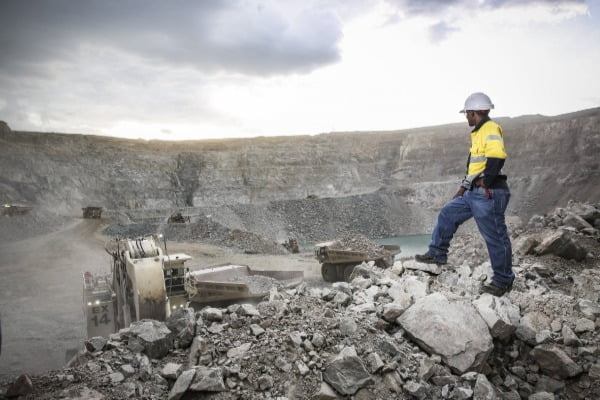ZIMBABWE MINING PERFOMANCE IN 2018 AND OUTLOOK

ZIMBABWE’S mining industry has remained vibrant despite the county’s economic challenges, earning the country US$2.2 billion in the first 10 months of the year.
Staff Reporter
The top six minerals that contributed the bulk of export earnings were gold, platinum, diamonds, chrome, coal and nickel.
The industry now accounts for about 65% to 70% of the country’s exports, according to Reserve Bank of Zimbabwe governor, John Mangudya.
This, therefore, confirms that mining had overtaken agriculture as the anchor of the country’s economy.
The sector is forecast to grow by 10% in 2018.
The gold sector remains bullish and going forward, miners have pledged to produce up to 100 tonnes of the yellow metal annually if given adequate support by the government.
So far, gold miners have surpassed their yearly target of 30 tonnes in the 10 months to October, with small scale miners producing 20,4 tonnes of the total production while primary producers, who are battling to stay afloat due to foreign currency shortages, contributed a meager 9,82 tonnes.
The 30-tonne output is the highest recorded since the country attained independence in 1980. Before this record, the country had 27, 1 tonnes recorded in 1999 as the highest output.
In the period January to September 2018, diamond recorded a 22% increase from 1.8 million carats to 2,2 million carats, lithium minerals witnessed a 45% increase from 34 110 tonnes to 49 359 tonnes, while granite production increased by 46% from 109 600 tonnes to 160 600 tonnes. Coal output grew by 4% from 2,3 million to 2,4 million tonnes.
Platinum Group Metals recorded marginal increases of around 1%.
While performance of the mining sector has predominantly been encouraging to date, the outlook for the full year and going forward is being threatened by foreign currency and capital shortages, rising production costs (largely propped up by high input costs in the domestic market and high electricity charges), and suboptimal fiscal charges, among other constraints, according to Chamber of Mines of Zimbabwe chief executive officer, Isaac Kwesu.
Zimbabwe Miners’ Federation (ZMF) spokesperson, Dosman Mangisi said mining sector has witnessed some significant positive changes so far despite some challenges associated with foreign currency.
“As small scale miners, we have already surpassed our target by 21 tonnes. As the year-ends, you can see that definitely it will be more positive despite some challenges,” Mangisi said.
Achievements so far
As highlighted earlier, the majority of key minerals posted significant output growth in the period between January and September. This marked an achievement. Government in 2016, through Fidelity Printers and Refiners (FPR), established a Gold Development Initiative Fund (GDIF) to support gold mining operations in the country.
The fund is currently standing at $150 million, up from $20 million in 2016.
The country’s sole gold buying unit, FPR has attributed the sharp increase in gold output to the funding support, which helped equip many miners and enhanced their capacity.
FPR and ZMF, an umbrella body for small-scale miners in the country, have managed to encourage miners to sell their gold through formal channels. FPR has gone to the extent of allowing those with small quantities of gold to sell their mineral upon production of only an identity document.
Government also liberalised and decentralised gold processing and buying centres, a development that has gone a long way in enticing formal gold deals and reducing leakages.
What needs to be improved come 2019?
There are some areas needing attention especially with the fact that government wants mining to anchor economic growth and transformation towards its Vision 2030 of making Zimbabwe a middle income country.
For instance, the industry is expected to reach $11 billion by 2022, and $18 billion by 2030.
But to achieve this feat, there is need to address foreign currency and capital shortages, rising production costs, and suboptimal fiscal charges, among other constraints.
Mangisi said there was need of ease of doing business in the mining industry, citing the issue of Exclusive Prospecting Orders (EPO’s).
“There is this issue of EPO’s being all over the country. For example, people in Matabeleland South cannot peg and explore. That’s wrong. It’s totally wrong and against development and growth of the mining industry because you have already the sector in that area and even the opportunities in that area have been also made dormant,” he said.
“So there is need to make special consideration and engagements before putting these EPO’s. This is because when an EPO is gazetted, it means no ordinary person can go and mine,” Mangisi said.
There is also need to shorten the time of processing mining documents, he said.
“For now, to get a certificate it takes you three months, something that can be done within 21 days. That’s not healthy for the mining industry especially for investors who want to put in their money,” he said.
Mangisi said there was need for government to decentralise administration of matters involving players in the mining sector given that all everything was being done in Harare at the moment.
“Other departments like the Environmental Management Agency have decentralised their services. At the moment, the Environmental Impact Assessments (EIAs) applications are processed at provincial level. They are no long being sent to Harare. So we expect those things like rebate of equipment and duties be done at provincial level. Why one should go to Harare from Bulawayo or Mphoengs for that? It discourages the sector,” he said.
Mangisi said gold miners should be paid 100% of their foreign currency earnings.
“There is no secret about it. Even in all those minerals that we are mining, miners should have access to their money because mining is a capital intensive sector. If they are not paid in forex, they will shut down because if you look in Zimbabwe majority of things that we have especially equipment are being imported,” he said.
“We don’t manufacture these things here in Zimbabwe. And even our companies don’t manufacture compressors. Some are just assembling. Mining consumables are not manufactured in the country. So why should they be denied their forex?” Mangisi said.
Small scale miners also feel that the GDIF should be reviewed, as currently, the fund had become a liability to miners.
“With this issue of forex, that fund whilst there some positives about it but with that introduction of 2% tax on electronic transactions, it has affected almost everything because local manufacturers no longer want bond notes,” he said.
“If you want to buy in bond, they will charge times five more. This makes loans a liability to a miner.”
Miners also want government to give them some tax incentives and some exemptions to boost the mining industry.
There is also need to capacitate small scale chrome miners as they are currently not receiving any financial support from government and are self-funded.
Chrome miners, through their consultancy, Mantle Consulting Group are lobbying government, demanding the central bank to pay them 80% in foreign currency and 20% in real time gross settlement (RTGS).
“The current fiscal environment in which small scale chrome miners operate in is not sustainable. We are noting a number of miners who invested their own capital into operations either slowing production or for financial reasons shutting down their mining operations,” the miners said.
Currently, the central bank pays miners 35% in forex and 65% RTGS.
Chrome mining requires heavy mining machinery such as front end loaders, dump trucks, tipper trucks, excavators, drill riggs, bull dozers, and graders. All this equipment, apart from being expensive, requires maintenance.
“Without the above inputs chrome mining is reduced to its basic and unsustainable form of pick and shovel mining which is not commercially viable. In most cases, mines are not accessible and the chrome ore mined cannot be moved or accessed without the key equipment noted above which is why we note that pick and shovel operations are not sustainable,” miners said.
These are some of the things needing government’s attention if the mining sector is to grow significantly.
This articles first appeared in the Mining Zimbabwe Magazine December 2018 Issue


